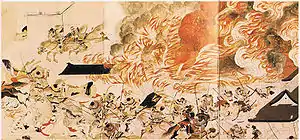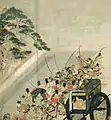Siege of Sanjō Palace
The Siege of the Sanjō Palace was the primary battle of the Heiji Rebellion.[1] In early January 1160, after Taira no Kiyomori left Kyoto on a family pilgrimage, Fujiwara no Nobuyori and Minamoto no Yoshitomo saw an opportunity to effect changes they sought in the government. With a force of roughly five hundred men, they attacked in the night, kidnapped former emperor Emperor Go-Shirakawa, and set fire to the palace. They also abducted and imprisoned the then current emperor, Emperor Nijō, who supported their enemies, the Taira clan and Fujiwara no Michinori.[2]
| Siege of the Sanjō Palace | |||||||
|---|---|---|---|---|---|---|---|
| Part of the Heiji Rebellion | |||||||
 Night Attack on the Sanjō Palace (handscroll detail) | |||||||
| |||||||
| Belligerents | |||||||
| Minamoto Clan, with Fujiwara no Nobuyori | Taira Clan, with Fujiwara no Michinori | ||||||
| Commanders and leaders | |||||||
| Minamoto no Yoshitomo | Taira no Kiyomori | ||||||
| Strength | |||||||
| 500? | Unknown | ||||||
They next attacked the manor house of Michinori, setting it too aflame and killing all those inside, with the exception of Michinori himself, who was captured later and decapitated. Nobuyori forced Emperor Nijō to name him imperial chancellor, completing one of the first important steps toward growing his political power.[2]
However, Taira no Kiyomori soon returned afterwards with his son Taira no Shigemori and a small force. The Minamoto, reinforced with men from Kamakura led by Yoshitomo's eldest son Minamoto no Yoshihira, although the larger force, were unprepared and hesitated at Kiyomori's return. Thus the Taira were allowed to return to their family mansion in the Rokuhara district, plan tactics and strategies, and bolster their force.[2]
At the end of January, the Taira smuggled the Emperor Nijō and his empress consort (disguised as a lady in waiting) out of the Sanjō Palace and into the Rokuhara mansion, while also helping the former Emperor Go-Shirakawa escape from the Minamoto as well.[2]
On the morning of February 5, Minamoto no Yoshitomo and his men prepared to defend the palace against the inevitable Taira assault. The Minamoto were initially able to hold. But a portion of the Taira feigned retreat, luring Minamoto warriors out of the Palace. This gave the rest of the Taira force an opportunity to rush the gates and, soon afterwards, drive the Minamoto out. Yoshitomo's men were then forced to attack the Rokuhara mansion, but ultimate failed. In the wake of their failure, they fled Kyoto, meeting resistance along the way from the warrior monks of Mount Hiei whom they had attacked in decades past.[2]


